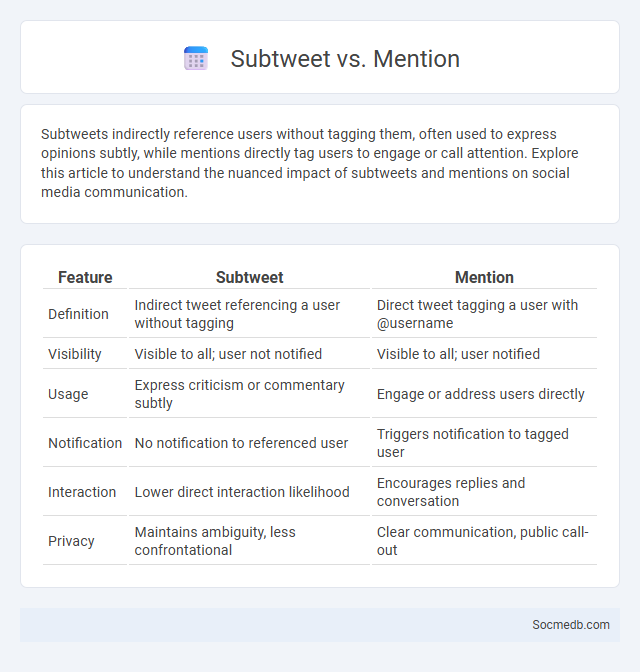
Photo illustration: Subtweet vs Mention
Subtweets indirectly reference users without tagging them, often used to express opinions subtly, while mentions directly tag users to engage or call attention. Explore this article to understand the nuanced impact of subtweets and mentions on social media communication.
Table of Comparison
| Feature | Subtweet | Mention |
|---|---|---|
| Definition | Indirect tweet referencing a user without tagging | Direct tweet tagging a user with @username |
| Visibility | Visible to all; user not notified | Visible to all; user notified |
| Usage | Express criticism or commentary subtly | Engage or address users directly |
| Notification | No notification to referenced user | Triggers notification to tagged user |
| Interaction | Lower direct interaction likelihood | Encourages replies and conversation |
| Privacy | Maintains ambiguity, less confrontational | Clear communication, public call-out |
Understanding Subtweets: A Silent Communication
Subtweets are indirect messages posted on social media that reference someone without tagging them, allowing users to express opinions or frustrations subtly. Understanding subtweets can help you decode silent communication styles in online interactions and navigate social dynamics more effectively. Recognizing the impact of subtweets on digital relationships enhances your ability to respond thoughtfully and maintain social harmony.
What is a Mention? Publicly Addressing Users
A mention on social media is the act of publicly addressing or tagging another user by including their username or handle in your post or comment. This feature notifies the mentioned user, increasing engagement and fostering direct communication within the platform. By using mentions effectively, Your content can reach targeted audiences and encourage interactive conversations.
Key Differences Between Subtweets and Mentions
Subtweets involve indirect references to a person or topic without using their handle, often to express opinions or criticisms discreetly. Mentions explicitly tag a user by including their social media handle, ensuring direct notification and engagement. Subtweets maintain subtlety and ambiguity, while mentions prioritize clarity and direct interaction.
Subtweet vs Mention: Impact on Online Discourse
Subtweets, indirect references without tagging, can intensify online discourse by fostering ambiguity and speculation, often escalating conflicts or passive-aggressive exchanges. Mentions, direct tags including usernames, promote transparency and accountability in conversations, facilitating clearer communication and engagement. Understanding the distinct impact of subtweets versus mentions helps users navigate social media interactions more effectively to influence conversation tone and community dynamics.
When to Use a Subtweet vs a Mention
Subtweets are best used to indirectly reference someone without triggering a notification, ideal for expressing opinions or criticism discreetly on platforms like Twitter. Mentions directly tag the user, suitable for engaging conversations, giving credit, or seeking attention in threads and replies. Choosing between subtweets and mentions depends on the intent to either communicate openly or maintain a level of anonymity in social media interactions.
Social Etiquette: Subtweets and Mentions Compared
Subtweets and mentions represent distinct social etiquette practices on social media platforms like Twitter, affecting online communication dynamics. Subtweets imply indirect references without tagging, often sparking curiosity or controversy, whereas mentions directly engage specific users by tagging their handles, fostering transparent dialogue and accountability. Understanding the nuanced use of subtweets versus mentions is essential for maintaining respectful and effective social interactions in digital communities.
Subtweet Consequences: Navigating Digital Drama
Subtweeting can escalate conflicts on social media by indirectly targeting individuals, leading to misunderstandings and damaged relationships. Your digital reputation may suffer as subtweets often invite speculation and gossip, amplifying drama beyond your control. Managing subtweet consequences requires mindful communication and awareness of how your online actions impact both personal and professional networks.
Pros and Cons of Subtweeting vs Mentioning
Subtweeting allows users to express opinions indirectly, maintaining anonymity while potentially avoiding direct confrontations, which can protect social relationships but often leads to misunderstandings and reduced clarity. Mentioning directly targets individuals or groups, fostering transparency, accountability, and clear communication at the cost of potential conflict escalation and public exposure. Both practices impact online social dynamics differently, influencing user engagement, conflict resolution, and community cohesion on platforms like Twitter and Instagram.
Identifying Subtweets: Signs and Examples
Subtweets often avoid mentioning your name directly but use vague language or context that clearly hints at you, such as indirect references to recent conversations or shared experiences. Look for posts that generate curiosity or controversy without explicit tags, often involving passive-aggressive tone or cryptic statements. Recognizing subtweets helps you understand underlying social dynamics and decide whether to engage or ignore the implicit message.
Best Practices for Responsible Twitter Communication
Effective Twitter communication involves clear, concise messaging that respects community guidelines and promotes positive engagement. Prioritize fact-checking to prevent the spread of misinformation and use inclusive language to foster respectful interactions. Regularly monitoring tweet performance and audience feedback helps refine strategies for enhanced reach and meaningful dialogue.
 socmedb.com
socmedb.com